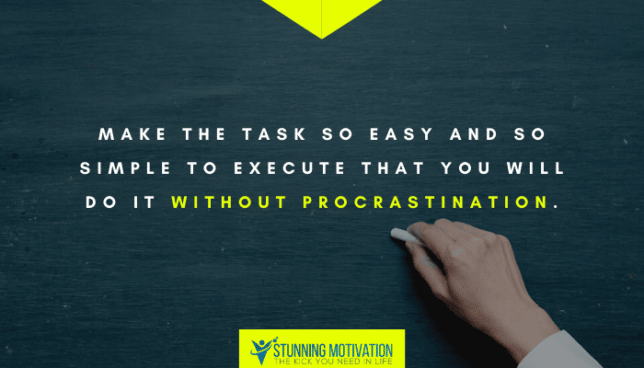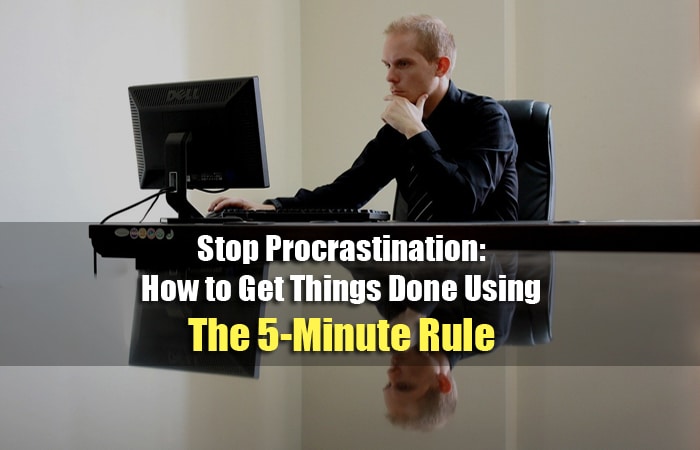Let’s face it, there are times when we know what we need to do, but we just don’t want to do it because we don’t have the motivation and don’t feel like doing it. We procrastinate and we end up not getting anything done.
Regardless of whether it is to file a report, to do the laundry, to write an article, to clean up the house, or to read a 300-page book, there are times when we feel totally zero motivation and we just want to procrastinate or do something else.
Why is that?
If you want to overcome this lack-of-motivation problem, here’s one thing you have to understand: our motivation is greatly affected by our moods.
In other words, it is our emotions that will determine whether we feel motivated or not.
This explains why after you read an inspirational book, you feel driven and you want to take massive actions.
But at other times, you can feel lousy, sleepy, tired, and exhausted that you just don’t want to do anything at all.
The Elephant and the Rider
In the best-selling book, Switch: How to Change Things When Change Is Hard, the authors explain that our brains operate with 2 systems: the emotional and the rational side.
The book also uses the metaphor of an Elephant and a Rider. Our rational side is the Rider while our emotional side is the Elephant.
The Elephant (your emotion) is strong and powerful, and it can be ruthless at times.
The Rider is your logical side that you can use to control the Elephant. But, if the Elephant is not tamed, it can quickly and easily overpower the rider.
We all experienced this. The time when you slept in, procrastinated, skipped the gym, gotten angry, abandoned your goals, refused to speak up, etc.
We know we need to do it (the Rider knows), but the Elephant inside us stop us from doing it.
I strongly suggest you read the book. It is an interesting and insightful book about why we do what we do. And how you can “hack” yourself to get things done.
Change is Easy When the Elephant and Rider Move Together
We often fail to find the motivation because the Rider (our logical side) knows what to do, but the Elephant in us (our emotional side) doesn’t want to do it.
The Elephant is hungry for instant gratification. It is always looking for comfort and refuses to change.
On the other hand, the Rider has the ability to think long-term, to plan, and to set goals. But there is a serious weakness in the Rider: is overanalyzing and overthinking things.
A reluctant Elephant and a wheel-spinning Rider can both ensure nothing changes and no positive progress in your life.
However, when the Elephant and the rider move together, change and progress can come easily.
Read the book. And learn how you can master yourself for positive change.
==> Switch: How to Change Things When Change Is Hard
Lower the Resistance and Make the Task Easy
So, now that you understand motivation is about getting the elephant to move, how can you do that?
One powerful method is to shrink the change.
In other words, you want to lower the resistance and make the task so easy that you can’t find any excuses to say no.
You want to make the task so easy and so simple to execute that you will do it without procrastination.

Do you get it?
Think about it, writing a 1,000 words article is difficult. But what if you just need to come up with the article title? Do you think you can do it?
How about hitting the gym? Getting yourself change, drive to the gym, finding the parking, sweating for an hour, take a shower, and then drive all the way home may seem like a lot of daunting tasks.
But what if your job is to just get yourself change into sports attire? Or perhaps to get an Uber driver from your phone to drive you to your gym? Don’t you think that out of sudden your task becomes easier?
The key is to shrink the change and to lower your resistance to working on the task.
Listen, you want to commit yourself to do just the first step.
Instead of spending 3 hours cleaning the entire house, you just need to spend 15 minutes washing the dishes. You break down your project into smaller and manageable tasks.
You see, when the task becomes easier, the motivation you need to execute the task will become lower too.
You want to lower the resistance so that you will have the motivation to get the work done, do you get it?
The Effect of Shrinking the Change and Lowering Resistance
Two car wash companies offered a promotional deal. When you drive your car to wash in the company, you will get a free stamp.
The first car wash company offers a free car wash after 5 stamps while the second car company offers a free car wash after 10 stamps, but the second company gives a card with 5 stamps ready.
In other words, both require 5 stamps to get a free car wash. The only difference is that the second company started with 5 stamps upfront for their customers.
The result?
A few months after this promotion, the second company had a 34 percent market share versus 19 percent for the first company.
The second company gives its customers the perceptions, feelings, and beliefs to think that they are 50% on their way to their goal.
It helps a lot when you think that you don’t have to start from zero.
For instance, if your goal is to save $100,000 in your bank account, saving $10 today doesn’t seem like you’re making huge progress, isn’t it?
But if you break down your target to saving $100 a week, putting $10 today may seem like making quite a lot of progress.
Of course, your aim is still to save $100,000, but when you shrink the change and lower the resistance, you put yourself in a position where you’re more willing to act on your goal.
The story tells us that when we are further along to our goal, the more likely we will work toward our goal.
When you have some success, it is easier for you to build on that success and keep going.
So, how can you apply this principle into your daily life to get things done?
Introducing: The 5-Minute Rule
Follow the 5-Minute Rule, meaning, do the work for just 5 minutes.
Rather than writing the article in one sitting that can take you about an hour, focus on writing the article for just 5 minutes.
Instead of hitting the gym and exercise for an hour, commit yourself to exercise for just 5 minutes.
You don’t have to spend an hour to clean your house, just start with 5 minutes. You can throw the trash, do a little organizing, or just clean the closet. All you need to do is to commit to the work for just 5 minutes.
Yes, shrink the change by doing the work for just 5 minutes. That’s all. Just a short 5 minutes.
You may ask what can you accomplish within 5 minutes, right?
That’s exactly the point. You want to put yourself into the action mood and build up your momentum.
Think about it, if your goal is to write a 300-page book, you can’t write the entire book in one go.
It’s an enormous task and if you try to cramp everything all together, you will feel stressed, pressured, and paralyzed. And guess what you will do next? Procrastination.
What you need to do is to break down the task and work on the bite sizes tasks. If you write just one page a day, you will have 365 pages after a year.
You want to lower the bar first so that you will produce some success.
If you set the bar too high, it makes you feel overwhelming and you will tend to procrastinate more often.
Read: Why Start Small? The 5 Important Benefits of Starting Small
Why The 5-Minute Rule Works
The 5-Minute Rule works because this rule focuses on 3 main fundamentals of change:
1. Focus on a specific task.
When you focus on doing the work for just 5 minutes, you need to be specific about it. Consider:
- Build a successful blog, and
- Write a content article for just 5 minutes.
As you can see from the 2 measures above, the first measure is big and vague. You don’t have a specific and actionable step to focus on.
The second measure requires you write an article for 5 minutes. The action is clear, specific, and to the point.
When you apply the 5-Minute Rule, you are giving your mind a specific instruction an action to focus on.
2. Give you an immediate result.
We all want to see results immediately. We don’t want to wait for months or even years to reach our goals or to become successful.
Human beings are always looking for instant gratification. We want things and we want it immediately. Like a baby when asking for milk. When the baby is hungry, she wants milk immediately. If you don’t give it to her, she will cry out loud.
And when you apply the 5-Minute Rule, you are creating progress instantly, which makes you feel good.
Once you started to exercise for 5 minutes, you started to feel the heat and sweat. You will feel like you are making progress and wanted to do more.
The key is that when you take action, you are creating small victories. And these victories will motivate you to take even more action.
3. Build up your momentum.
You want to put yourself into the action mode, like what Tony Robbins said:
“People who succeed have momentum. The more they succeed, the more they want to succeed, and the more they find a way to succeed. Similarly, when someone is failing, the tendency is to get on a downward spiral that can even become a self-fulfilling prophecy.”
You want to make sure you built up the upward momentum and not the downward one.
When you take a small action, you are creating inertia and building up your momentum. The more actions you take, the more results you produce.
And the more results you get, the more confident you will be. The more confident you are, the more actions you are going to take. And the cycle continues.
On the other hand, you can fall into the downward momentum spiral too.
If you choose to sit and do nothing. You will feel lousy and inferior. You feel like you are a loser. And the more you feel this way, the less confident you will be.
And when you lose your confidence, you don’t want to take action because you don’t think that you can do it. And without action, you get no results. When you don’t produce any result, you have just proved yourself right – you are a loser.
It is a self-fulfilling prophecy. You become what you think about most of the time.
And in order to get yourself out of the downward cycle and into the upward cycle, just apply the 5-Minute Rule and produce small and immediate wins.
Read: Success Cycle: How to Leverage Small Success to Build Bigger Ones
Here’s What You Can Do
Take a look at your goals, tasks, or anything that you wanted to do but always find it difficult to do or any task that you always procrastinate.
Use the 5-Minute Rule and work on the task for just 5 minutes.
You don’t want to overwhelm yourself. You just want to commit to working on the task for 5 minutes.
Once the 5 minutes are up, it is your choice whether to continue the work or you can choose to stop.
You have to keep your own promise, right? So, if you commit to doing the work for just 5 minutes, then so be it. Once you have worked on the task for 5 minutes, stop.
If after 5 minutes you feel like you want to continue to do more, by all means, do it.
Of course, the key is to get things started. Once you have started, you will have gained some momentum. And the momentum is exactly what will get you to do another 5 minutes, and another 5 more minutes until you get the task done.
Conclusion
I hope this rule helps you achieve more in life. We all tend to procrastinate on our goals and dreams. We often feel overwhelmed and have no idea where to begin.
By using the 5-Minute Rule, you get rid of your resistance and able to produce immediate wins, which boost your momentum.
Again, I suggest you read the book, Switch: How to Change Things When Change Is Hard. It is a great book that I strongly recommend you read if you want to make a positive change in your life.
Shawn is a passionate coach who empowers individuals to achieve their goals and reach new heights of success. With his experience in the personal development industry, Shawn has guided countless people towards fulfilling their potential and achieving outstanding results in life. He has experience in the personal development industry for more than 7 years and has helped countless success seekers to achieve outstanding success in life. Learn more about him on Everydaypower.com or Goalcast.com



















2 Responses